Snopes Our Desire is to Confront the Culture in Ways That Will Continue to Advance Gods Kingdom
People packed in by the thousands, many dressed in red, white and blue and carrying signs reading "Four more years" and "Make America Great Again". They came out during a global pandemic to make a statement, and that's precisely why they assembled shoulder-to-shoulder without masks in a windowless warehouse, creating an ideal environment for the coronavirus to spread.
US President Donald Trump's rally in Henderson, Nevada, on 13 September contravened state health rules, which limit public gatherings to 50 people and require proper social distancing. Trump knew it, and later flaunted the fact that the state authorities failed to stop him. Since the beginning of the pandemic, the president has behaved the same way and refused to follow basic health guidelines at the White House, which is now at the centre of an ongoing outbreak. The president spent 3 days in a hospital after testing positive for COVID-19, and was released on 5 October.
Trump's actions — and those of his staff and supporters — should come as no surprise. Over the past eight months, the president of the United States has lied about the dangers posed by the coronavirus and undermined efforts to contain it; he even admitted in an interview to purposefully misrepresenting the viral threat early in the pandemic. Trump has belittled masks and social-distancing requirements while encouraging people to protest against lockdown rules aimed at stopping disease transmission. His administration has undermined, suppressed and censored government scientists working to study the virus and reduce its harm. And his appointees have made political tools out of the US Centers for Disease Control and Prevention (CDC) and the Food and Drug Administration (FDA), ordering the agencies to put out inaccurate information, issue ill-advised health guidance, and tout unproven and potentially harmful treatments for COVID-19.
"This is not just ineptitude, it's sabotage," says Jeffrey Shaman, an epidemiologist at Columbia University in New York City, who has modelled the evolution of the pandemic and how earlier interventions might have saved lives in the United States. "He has sabotaged efforts to keep people safe."
The statistics are stark. The United States, an international powerhouse with vast scientific and economic resources, has experienced more than 7 million COVID-19 cases, and its death toll has passed 200,000 — more than any other nation and more than one-fifth of the global total, even though the United States accounts for just 4% of world population.
Quantifying Trump's responsibility for deaths and disease across the country is difficult, and other wealthy countries have struggled to contain the virus; the United Kingdom has experienced a similar number of deaths as the United States, after adjusting for population size.
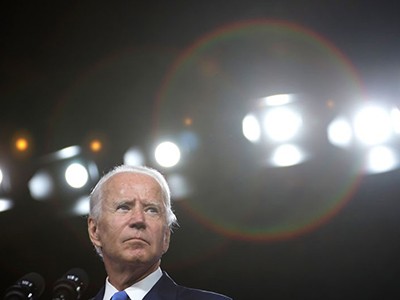
What a Joe Biden presidency would mean for five key science issues
But Shaman and others suggest that the majority of the lives lost in the United States could have been saved had the country stepped up to the challenge earlier. Many experts blame Trump for the country's failure to contain the outbreak, a charge also levelled by Olivia Troye, who was a member of the White House coronavirus task force. She said in September that the president repeatedly derailed efforts to contain the virus and save lives, focusing instead on his own political campaign.
As he seeks re-election on 3 November, Trump's actions in the face of COVID-19 are just one example of the damage he has inflicted on science and its institutions over the past four years, with repercussions for lives and livelihoods. The president and his appointees have also back-pedalled on efforts to curb greenhouse-gas emissions, weakened rules limiting pollution and diminished the role of science at the US Environmental Protection Agency (EPA). Across many agencies, his administration has undermined scientific integrity by suppressing or distorting evidence to support political decisions, say policy experts.
"I've never seen such an orchestrated war on the environment or science," says Christine Todd Whitman, who headed the EPA under former Republican president George W. Bush.
Trump has also eroded America's position on the global stage through isolationist policies and rhetoric. By closing the nation's doors to many visitors and non-European immigrants, he has made the United States less inviting to foreign students and researchers. And by demonizing international associations such as the World Health Organization, Trump has weakened America's ability to respond to global crises and isolated the country's science.
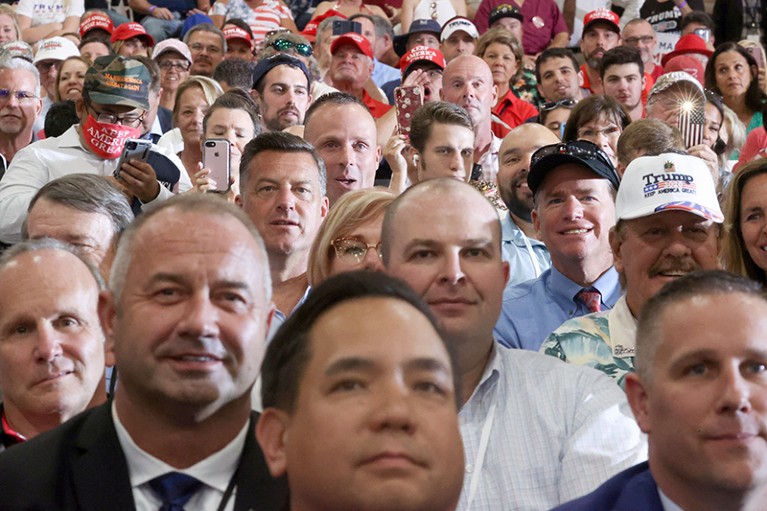
Supporters of President Trump — many without masks — crowded into an indoor facility in Henderson, Nevada, on 13 September. Credit: Jonathan Ernst/Reuters
All the while, the president has peddled chaos and fear rather than facts, as he advances his political agenda and discredits opponents. In dozens of interviews carried out by Nature, researchers have highlighted this point as particularly worrisome because it devalues public trust in the importance of truth and evidence, which underpin science as well as democracy.
"It's terrifying in a lot of ways," says Susan Hyde, a political scientist at the University of California, Berkeley, who studies the rise and fall of democracies. "It's very disturbing to have the basic functioning of government under assault, especially when some of those functions are critical to our ability to survive."
The president can point to some positive developments in science and technology. Although Trump hasn't made either a priority (he waited 19 months before appointing a science adviser), his administration has pushed to return astronauts to the Moon and prioritized development in fields such as artificial intelligence and quantum computing. In August, the White House announced more than US$1 billion in new funding for those and other advanced technologies.
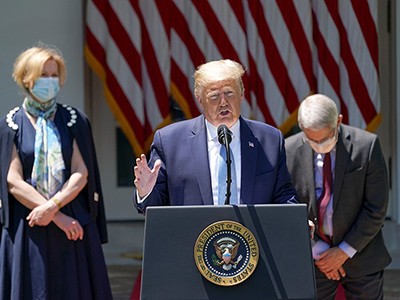
A four-year timeline of Trump's impact on science
But many scientists and former government officials say these examples are outliers in a presidency that has devalued science and the role it can have in crafting public policy. (A timeline chronicles Trump's actions related to science.)
Much of the damage to science — including regulatory changes and severed international partnerships — can and probably will be repaired if Trump loses this November. In that event, what the nation and the world will have lost is precious time to limit climate change and the march of the virus, among other challenges. But the harm to scientific integrity, public trust and the United States' stature could linger well beyond Trump's tenure, says scientists and policy experts.
As the election approaches, Nature chronicles some of the key moments when the president has most damaged American science and how that could weaken the United States — and the world — for years to come, whether Trump wins or loses to his opponent, Joe Biden.
Climate harmed
Trump's assault on science started even before he took office. In his 2016 presidential campaign, he called global warming a hoax and vowed to pull the nation out of the landmark 2015 Paris climate agreement, signed by more than 190 countries. Less than five months after he moved into the White House, he announced he would fulfil that promise.
"I was elected to represent the citizens of Pittsburgh, not Paris," Trump said, arguing that the agreement imposed energy restrictions, cost jobs and hampered the economy in order to "win praise" from foreign leaders and global activists.
What Trump did not acknowledge is that the Paris agreement was in many ways designed by — and for — the United States. It is a voluntary pact that sought to build momentum by allowing countries to design their own commitments, and the only power it has comes in the form of transparency: laggards will be exposed. By pulling the United States out of the agreement and backtracking on climate commitments, Trump has also reduced pressure on other countries to act, says David Victor, a political scientist at the University of California, San Diego. "Countries that needed to participate in the Paris process — because that was part of being a member in good standing of the global community — no longer feel that pressure."
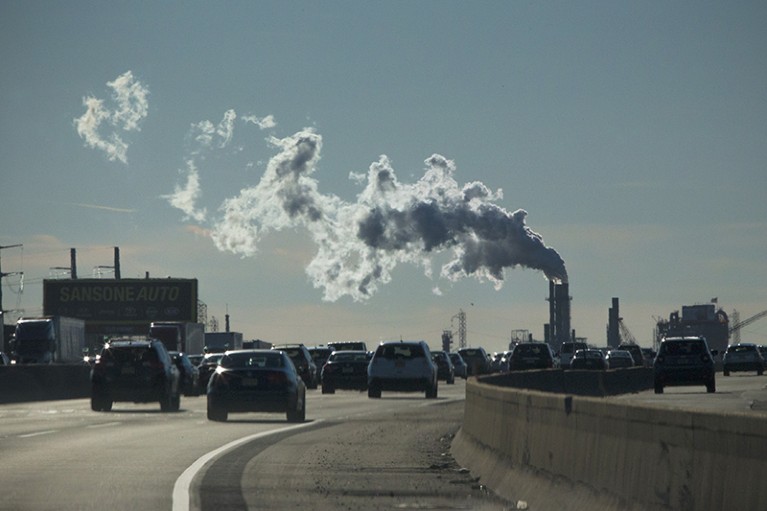
The Environmental Protection Agency has rolled back regulations on greenhouse-gas emissions. Credit: Kena Betancur/VIEWpress/Corbis via Getty
After Trump announced his decision on the Paris accord, his appointees at the EPA set about dismantling climate policies put in place under former president Barack Obama. At the top of the list were a pair of regulations targeting greenhouse-gas emissions from power plants and automobiles. Over the past 15 months, the Trump administration has gutted both regulations and replaced them with weaker standards that will save industry money — and do little to reduce emissions.
In some cases, even industry objected to the rollbacks. The administration's efforts prompted objections from several carmakers, such as Ford and Honda, which last year signed a separate agreement with California to maintain a more aggressive standard. More recently, energy giants such as Exxon Mobil and BP opposed the administration's move to weaken rules that require oil and gas companies to limit and eliminate emissions of methane, a powerful greenhouse gas.
According to one estimate from the Rhodium Group, a consultancy based in New York City, the administration's rollbacks could boost emissions by the equivalent 1.8 billion tonnes of carbon dioxide by 2035 — roughly five times the annual emissions of the United Kingdom. Although these measures could be overturned by the courts or a new administration, Trump has cost the country and the planet valuable time.
"The Trump era has been really a terrible, terrible time for this planet," says Leah Stokes, a climate-policy researcher at the University of California, Santa Barbara.
The Trump administration formally filed the paperwork to exit the Paris agreement last year, and the US withdrawal will become official on 4 November, one day after the presidential election. Most nations have vowed to press forward even without the United States, and the European Union has already helped to fill the leadership void by pressing nations to bolster their efforts, which China did on 22 September when it announced that it aims to be carbon neutral by 2060. Biden has promised to re-enter the agreement if he wins, but it could be difficult for the United States to regain the kind of international influence it had under Obama, who helped energize the climate talks and bring countries on board for the 2015 accord.
"Rejoining Paris is easy," Victor says. "The real issue is credibility: will the rest of the world believe what we say?"
War on the environment
Trump hasn't just gone after regulations. At the EPA, his administration has sought to undermine the way the government uses science to make public-health decisions.
The scale of the threat came into focus on 31 October 2017 — Halloween — when then EPA administrator Scott Pruitt signed an order barring scientists with active EPA research grants from serving on the agency's science-advisory panels, making it harder for people with the most expertise to help the agency assess science and craft regulations. The order made it easier for industry scientists to replace the academic researchers, who would be forced to either give up their grants or resign.

Five ways that Trump is undermining environmental protections under the cover of coronavirus
"That was when I said, 'Oh my god, the fix is in," says John Bachmann, who spent more than three decades in the EPA's air-quality programme and is now active in a group of retired EPA employees that formed to advocate for scientists and scientific integrity at the agency, after Trump officials began their assault. "It's not just that they have their own views, it's that they are going to make sure that their views carry more weight in the process."
Pruitt's order, which would eventually be overturned by a federal judge, was part of a broader effort to accelerate turnover and appoint new people to the panels. And it was just the beginning. In April 2018, Pruitt revealed a "science transparency" rule to limit the agency's ability to base regulations on research for which the data and models are not publicly available. The rule could exclude some of the most rigorous epidemiological research linking fine-particulate pollution to premature death, because much of the underlying patient data are protected by privacy rules. Critics say that this policy was aimed at raising doubts about the science and making it easier to pursue weak air-pollution standards.
Pruitt resigned in July 2018, but the trend at the EPA continues. Under its new administrator, Andrew Wheeler, the agency has accelerated efforts to weaken regulations targeting chemicals in water and air pollution.
Whitman, the former EPA chief, says there's nothing wrong with revisiting regulatory decisions by past administrations and altering course. But decisions should be based on a solid scientific analysis, she says. "We don't see that with this administration."
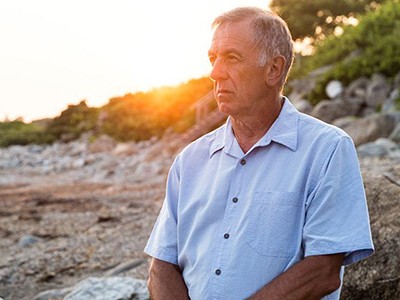
Science under siege: behind the scenes at Trump's troubled environment agency
One of the biggest recent decisions at the EPA came in the air-quality programme. On 14 April this year, amid the COVID-19 pandemic, the EPA proposed to maintain current standards for fine-particulate pollution, despite evidence and advice from government and academic scientists who have overwhelmingly backed tighter regulations.
"It's devastating, totally devastating," says Francesca Dominici, an epidemiologist at Harvard University in Boston, Massachusetts, whose group found that strengthening standards could save tens of thousands of lives each year. "Not listening to science and rolling back environmental regulations is costing American lives."
Pandemic problems
The coronavirus pandemic has brought the perils of ignoring science and evidence into sharp focus, and one thing is now clear: the president of the United States understood that the virus posed a major threat to the country early in the outbreak, and he chose to lie about it.
Speaking to Washington Post journalist Bob Woodward on 7 February, when only 12 people in the United States had tested positive for the coronavirus, Trump described a virus that is five times more lethal than the even the most "strenuous flus". "This is deadly stuff," Trump said in the recorded interview, which was released only in September.
In public, however, the president presented a very different message. On 10 February, Trump told his supporters at a rally not to worry, and said that by April, when temperatures warm up, the virus would "miraculously go away". "This is like a flu," he told a press conference on 26 February. In a TV interview a week later: "It's very mild."
In another recorded interview with Woodward on 19 March, Trump said he had played down the risk from the beginning. "I still like playing it down because I don't want to create a panic," Trump said.
After the tapes were released, Trump defended his efforts to keep people calm while simultaneously arguing that he had, if anything, "up-played" the risk posed by the virus. But health experts say that explanation makes little sense, and that the president endangered the public by misrepresenting the threat posed by the virus.
All the while, scientists now know, viral transmission was surging across the country. Rather than marshalling the federal government's power and resources to contain the virus with a comprehensive testing and contact-tracing programme, the Trump administration punted the issue to cities and states, where politics and a lack of resources made it impossible to track the virus or provide accurate information to citizens. And when local officials started to shut down businesses and schools in early March, Trump criticized them for taking action.
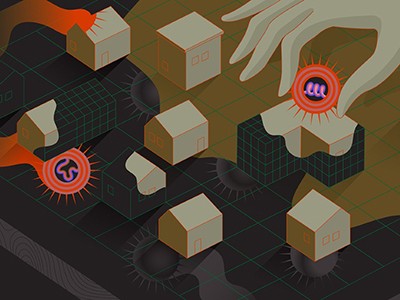
Two decades of pandemic war games failed to account for Donald Trump
"Last year, 37,000 Americans died from the common Flu," he tweeted on 9 March. "Nothing is shut down, life & the economy go on." Within a month, the US coronavirus death toll had topped 21,000, and the pandemic was in full stride, killing around 2,000 Americans every day.
Shaman and his colleagues at Columbia decided to investigate what might have happened had the country acted sooner. They developed a model that could reproduce what happened county by county across the United States from February to early May, as state and local governments shut down businesses and schools in an effort to halt the contagion. They then posed the question: what would have happened if everybody had done exactly the same one week earlier?
Their preliminary results, posted as a preprint on 21 May (S. Pei et al. Preprint at medRxiv https://doi.org/ghc65g; 2020), suggested that around 35,000 lives could have been saved, more than halving the death toll as of 3 May. If the same action had been taken two weeks earlier, that death toll could have been cut by nearly 90%. Reducing the initial exponential explosion in cases would have bought more time to roll out testing and address the inevitable outbreaks with targeted contact-tracing programmes.
"There's no reason on Earth this had to happen," Shaman says. "If we had gotten our act together earlier, we could have done much better."
Gerardo Chowell, a computational epidemiologist at Georgia State University in Atlanta, says that Shaman's study provides a rough approximation of how earlier action might have changed the trajectory of the pandemic, although pinning down precise numbers is difficult given the lack of data early in the pandemic and the challenge of modelling a disease that scientists are still trying to understand.
Trump responded publicly to the Columbia study by dismissing it as a "political hit job" by "an institution that's very liberal".
Control the message, not the virus
With the economy in freefall and a mounting death toll, Trump increasingly aimed his vitriol at China. The president backed an unsubstantiated theory suggesting that the virus might have originated in a laboratory in Wuhan, and argued that international health officials had helped China cover up the outbreak in the earliest days of the pandemic. On 29 May, he made good his threats and announced that he was pulling the United States out of the World Health Organization — a move that many say weakened the country's ability to respond to global crises and isolated its science.
For many experts, it was yet another counterproductive political manoeuvre from a president who was more interested in controlling the message than the virus. And in the end, he failed on both counts. Criticism mounted as COVID-19 continued to spread.
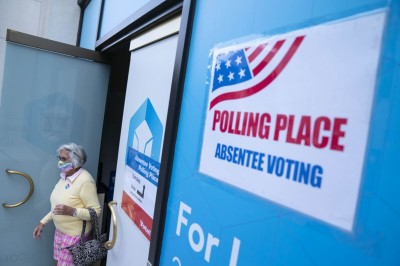
Science and the US presidential election: what do you think?
"The virus doesn't respond to spin," says Tom Frieden, who headed the CDC under Obama. "The virus responds to science-driven policies and programmes."
As the pandemic ground forward, the president continued to contradict warnings and advice from government scientists, including guidance for reopening schools. In July, Frieden and three other former CDC directors issued a sharp rebuke in a guest editorial in The Washington Post, citing unprecedented efforts by Trump and his administration to undermine the advice of public-health officials.
Similar concerns have arisen with the FDA, which must approve an eventual vaccine. On 29 September, seven former FDA commissioners penned another editorial in The Washington Post raising concerns about interventions by Trump and Department of Health and Human Services (HHS) secretary Alex Azar in a process that is supposed to be guided by government scientists.
This kind of political interference doesn't just undermine the public-health response, but could ultimately damage public trust in an eventual vaccine, says Ezekiel Emanuel, a bioethicist and vice-provost for global initiatives at the University of Pennsylvania in Philadelphia. "Everybody is wondering: 'Am I going to be able to trust the Food and Drug Administration's decision on the vaccine?'" says Emanuel. "That fact that people are even asking that question is evidence that Trump has already undermined the agency."
Elias Zerhouni, who headed the US National Institutes of Health under former president Bush from 2002 to 2008, says the Trump administration failed to control the coronavirus, and is now trying to force government agencies to use their prestige and manipulate science to buttress Trump's campaign. "They don't really get the science," says Zerhouni of Trump and his appointees. "This is the rejection of any science that doesn't fit their political views."
The White House and the EPA did not respond to several requests for comment. The HHS issued a statement to Nature saying: "HHS has always provided public health information based on sound science. Throughout the COVID-19 response, science and data have driven the decisions at HHS." The department adds: "President Trump has led an unprecedented, whole-of-America response to the COVID-19 pandemic."
Isolationist science
On 24 September, the US Department of Homeland Security proposed a new rule to restrict how long international students can spend in the United States. The rule would limit visas for most students to four years, requiring an extension thereafter, and impose a two-year limit for students from dozens of countries considered high-risk, including those listed as state-sponsors of terror: Iraq, Iran, Syria and the Democratic People's Republic of Korea.
Although it is not yet clear what effects this rule might have, many scientists and policy experts fear that this and other immigration policies could have a lasting impact on American science. "It could put the US at an enormous, enormous competitive disadvantage for attracting graduate students and scientists," says Lizbet Boroughs, associate vice president of the Association of American Universities in Washington, DC, a group representing 65 institutions.
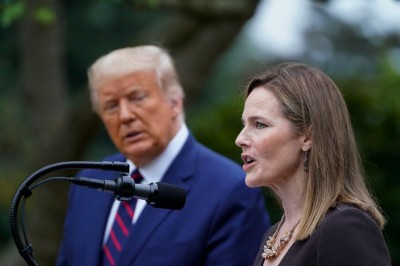
What Trump's Supreme Court pick could mean for science
It fits in with previously implemented travel restrictions that have made it more difficult for foreigners from certain countries — including scientists — to visit, study and work in the United States. These policies mark a sharp shift from previous governments, which have actively sought talent from other countries to fill laboratories and spur scientific innovation.
Researchers fear that the latest proposal will make the United States even less attractive to foreign scientists, which could hamper the country's efforts in science and technology.
"How we intersect with students from other countries has been hugely impacted," says Emanuel. If the best and brightest students from other countries start to go elsewhere, he adds, US science will suffer. "I fear for the country."
The proposed rule provides a glimpse of what a second Trump term might look like, and highlights the intangible impacts on US science that could endure even if Biden prevails in November. Biden could reverse some of the Trump administration's regulatory decisions and move to rejoin international organizations, but it could take time to repair the damage to the reputation of the United States.
James Wilsdon, a science-policy researcher at the University of Sheffield, UK, compares the US situation under Trump to the United Kingdom leaving the European Union, saying both countries are at risk of losing influence internationally. "Soft power is driven a lot by perception and reputation," Wilsdon says. "These are basically the intangible assets of the science system in the international arena." Whether or how quickly that translates into loss of competitiveness in attracting international scientists and students is unclear, he says, in part because scientists understand that Donald Trump doesn't represent US science.
On the domestic front, many scientists fear that increased polarization and cynicism could last for years to come. That would make it harder for government agencies to do their jobs, to advance science-based policies, and to attract a new generation to replace many of the senior scientists and officials who have decided to retire under Trump.
Re-establishing scientific integrity in agencies where government scientists have been sidelined and censored by political appointees won't be easy, says Andrew Rosenberg, who heads the Center for Science and Democracy at the Union of Concerned Scientists, an advocacy group based in Cambridge, Massachusetts, which has documented more than 150 attacks on science under Trump's tenure. "Under Trump, political appointees have the authority to override science whenever they want if it doesn't conform to their political agenda," Rosenberg says. "You can reverse that, but you have to do it very intentionally and very directly."
At the EPA, for example, it would mean rebuilding the entire research arm of the agency, and giving it real power to stand up to regulatory bodies that are making policy decisions, says one senior EPA official, who declined to be named because he is not authorized to speak to the press. The problem pre-dates Trump, but has accelerated under his leadership. Without forceful action, the official says, the EPA's Office of Research and Development, which conducts and assesses research that feeds into regulatory decisions, might simply continue its "long decline into irrelevance."
If Trump wins in November, researchers fear the worst. "The Trump folks have poured an acid on public institutions that is much more powerful than anything we've seen before," says Victor.
"People can shake some of these things off after one term, but to have him elected again, given everything he has done, that would be extraordinary. And the damage done would be much greater."
Source: https://www.nature.com/articles/d41586-020-02800-9
0 Response to "Snopes Our Desire is to Confront the Culture in Ways That Will Continue to Advance Gods Kingdom"
Postar um comentário